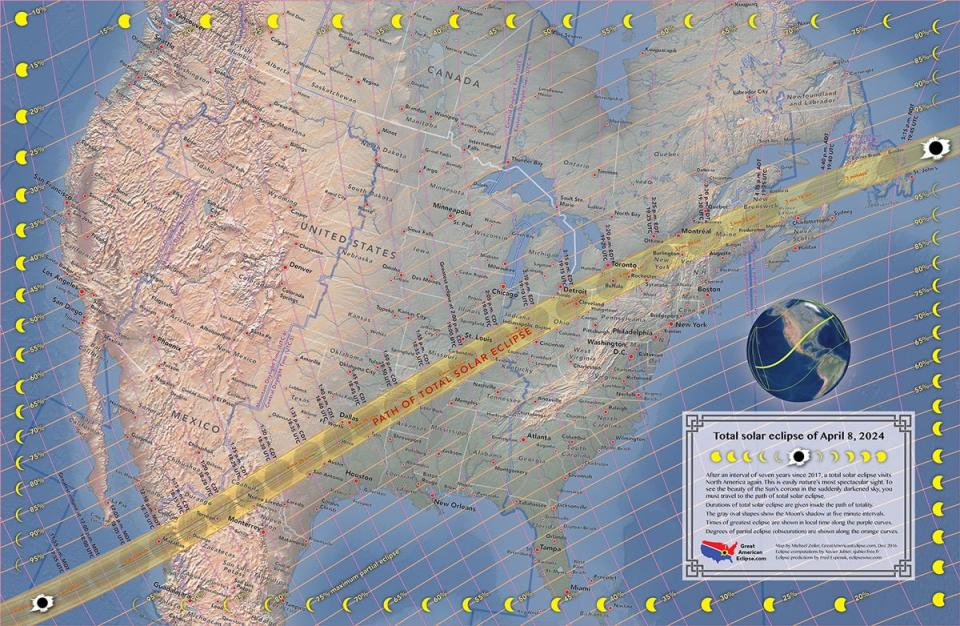Will the 2024 total solar eclipse hit near you? A detailed look at the path of totality.
Monday is your last shot of witnessing a total solar eclipse in North America for 20 years. Fortunately, the path of totality in the U.S. crosses from the bottom of Texas all the way to the tip of Maine, giving many Americans a good chance of finding a place within a reasonable distance to skygaze.
Even those who find themselves in a location in the continental United States outside the eclipse's direct path are likely to witness the stunning celestial event in some form. But when it comes to experiencing a total solar eclipse as rare and grandiose as the one days away, there's no doubt about it: The path of totality is the place to be.
Here's what to know about the 2024 total solar eclipse's path of totality, including the times and durations when darkness is expected to fall.
Solar eclipse experiment: Here's why NASA is launching 3 sounding rockets into space during the total solar eclipse
What is the path of totality?
Those in the direct line of the eclipse will be treated to an incredible sight as the moon completely blots out the sun's disk, ushering in uncharacteristic darkness and revealing the sun's elusive outermost layer called the corona. That moment is called "totality" and this year the path of totality crosses through 13 U.S. states.
The last total solar eclipse to cut through North America was in 2017. But astronomers say there won't be any comparison between that eclipse and the one coming Monday. For the 2024 eclipse, the corona will be brighter, the moon will appear larger and totality will last just a bit longer than it did seven years ago.
What U.S. cities and states are on the path of totality?
The 115-mile-wide path of totality will provide millions of spectators with a front row seat to its majesty as it passes through Mexico, the United States and Canada.
In the U.S., hundreds of cities and small towns fall directly on the path. An estimated 31 million Americans already live on the path this year, compared to just 12 million in 2017, according to eclipse cartographer Michael Zeiler at GreatAmericanEclipse.com.
Here are some of the major cities in each of the 13 states:
Dallas and San Antonio, Texas
Idabel, Oklahoma
Poplar Bluff, Missouri
Little Rock, Arkansas
Paducah, Kentucky
Indianapolis and Evansville, Indiana
Carbondale, Illinois
Cleveland and Toledo, Ohio
Buffalo, Rochester and Syracuse, New York
Burlington, Vermont
Lancaster, New Hampshire
Caribou, Maine
Erie, Pennsylvania
Additionally, small parts of Tennessee and Michigan are also expected to experience the eclipse, NASA says. In the United States, the eclipse's path will end in Maine before visiting the maritime provinces of Canada, according to estimates.
What time will totality occur in the United States?
Mexico's Pacific coast will be the first location in continental North America to experience totality, which will occur at about 11:07 a.m. PDT, according to NASA.
As the moon's shadow travels northeast, totality in the U.S. will begin at 1:27 p.m. CDT in Eagle Pass, Texas. From there, the path will cut diagonally across the country before ending around 3:33 p.m. EDT in Lee, Maine, according to nationaleclipse.com.

Along the way, periods of darkness could last a mere few seconds or, in some cities, could surpass four minutes.
Here are the major cities in each state where you can expect to experience totality in the United States (note that the included times do not account for when the partial eclipse begins and ends):
Dallas, Texas: 1:40-1:44 p.m. CDT
Idabel, Oklahoma: 1:45-1:49 p.m. CDT
Little Rock, Arkansas: 1:51-1:54 p.m. CDT
Poplar Bluff, Missouri: 1:56-2:00 p.m. CDT
Paducah, Kentucky: 2-2:02 p.m. CDT
Carbondale, Illinois: 1:59-2:03 p.m. CDT
Evansville, Indiana: 2:02-2:05 p.m. CDT
Cleveland, Ohio: 3:13-3:17 p.m. EDT
Erie, Pennsylvania: 3:16-3:20 p.m. EDT
Buffalo, New York: 3:18-3:22 p.m. EDT
Burlington, Vermont: 3:26-3:29 p.m. EDT
Lancaster, New Hampshire: 3:27-3:30 p.m. EDT
Caribou, Maine: 3:32-3:34 p.m. EDT
Did the path of totality change?
A new map from an amateur astronomer is projecting that the path of totality for Monday's solar eclipse may be narrower than experts previously believed.
If it's correct, some places, including several cities in Ohio, may now miss out on totality, while other places, including some additional cities in Texas, may now experience it.
But even if the new calculation is more accurate, it’ll likely be such a miniscule difference that it's unlikely to matter much for most of the millions of people who hope to witness the eclipse.
In fact, a NASA spokesperson told the Detroit Free Press that the U.S. space agency won't be making any alterations to its own calculations.

Do you need eclipse glasses during totality?
A total solar eclipse offers skygazers the rare opportunity to witness the eclipse with the naked eye. However, solar eclipse glasses are still needed until totality is reached.
Certified solar eclipse glasses are crucial for spectators to avoid the sun's retina-damaging rays. But when the moon moves completely in front of the sun and blocks its light, you'll know it's safe to remove the glasses for a short period of time.
Eric Lagatta covers breaking and trending news for USA TODAY. Reach him at [email protected]m
This article originally appeared on USA TODAY: Path of totality for 2024 solar eclipse: What states get best view?
